 |
|

|
 |
TABLE of CONTENTS
 |
Zelle brings private sector experience, public service commitment to job as MnDOT commissioner |
By Kevin Gutknecht
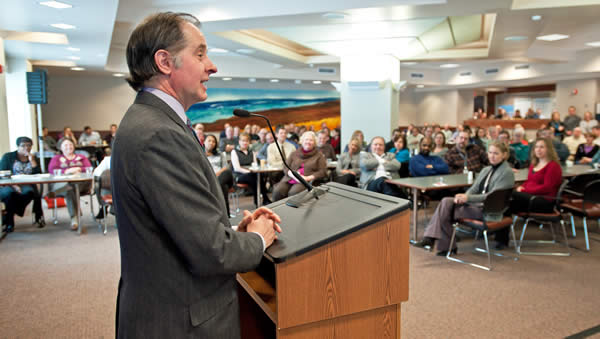
Commissioner Charlie Zelle meets with employees in St. Paul on Feb. 4. During the next few months, the commissioner will visit MnDOT’s districts to meet employees and get to know the organization better, as well as address employees via an upcoming webcast. Photo by David Gonzalez |
For Charlie Zelle, being named as MnDOT’s 18th commissioner allows him to get closer to the state’s transportation infrastructure, and the policy development that makes it work.
Zelle, who assumed the corner office in St. Paul on Jan. 15, found the move to MnDOT an easy choice.
“I have long had great admiration for MnDOT,” he said. “This job allows me to get engaged in an organization that I admire in a state I love.”
He discovered when he arrived that he had to hit the ground running. Deputy Commissioner Bernie Arseneau became ill that day and will be out of the office on medical leave for a number of weeks.
“It was out of the frying pan and into the fire,” Zelle said. “However, there are great people here who have stepped in while Bernie is away. And he is on the mend and doing well and will soon return.”
Zelle is no stranger to transportation and the state’s transportation infrastructure. He came to MnDOT from Jefferson Lines, an interstate bus company that has routes in 13 states. He has been with Jefferson for more than 20 years, and was most recently the company’s chairman and chief executive officer.
He also has spent the last year as a member of Governor Mark Dayton’s Transportation Finance Advisory Committee. This group studied Minnesota’s transportation system, analyzed its needs and developed a list of recommendations intended to keep the state on the path of transportation and economic stability.
Initially, Zelle’s MnDOT goals are to:
- Support those who are doing the great work at MnDOT
- Ensure that the agency is accountable and transparent
- Measure the agency’s successes, quantify those successes and then make the case for what Minnesota needs to be a world-class state
“MnDOT accomplishes many great things,” Zelle said. “I see my job as putting a voice to those great things and making sure the story gets out.”
See also: Charlie Zelle to become MnDOT commissioner Jan. 15 (MnDOT Newsline, Dec. 20, 2012)
The Senate Transportation and Public Safety Committee Jan. 28 unanimously recommended Charlie Zelle’s appointment as MnDOT’s commissioner.
The commissioner’s confirmation vote is scheduled to go before the full Senate on Feb. 7. |
|
 |
|

|
 |
TABLE of CONTENTS
 |
Winter adds another reason for caution around railroad tracks |
By Jessica Wiens
MnDOT reminds snowmobilers and motorists to always use caution and observe the law when near or crossing railroad tracks.
Preliminary 2012 data shows four fatalities at rail crossings. No fatalities on railroad property or crossings have been reported in 2013.
“A freight train moving at 50 mph may need more than a mile to stop,” said Susan Aylesworth, freight rail manager.
“Once train engineers see a vehicle or pedestrian in a crossing or on the tracks, they can apply the emergency brakes; however, it’s often too late for them to stop in time.”
Most collisions with trains are preventable. Inattention and impatience are cited as the most common factors contributing to motor vehicle/train crashes. In one recent incident, for example, a snowmobile got stuck on railroad tracks. While the owner left to get assistance, his snowmobile was struck by a freight train.
“It is important to contact authorities immediately if your vehicle or snowmobile stalls on the tracks,” Aylesworth said.
Other rail safety tips the public should follow include:
Snowmobilers and motorists should:
- Stop when crossing gates are down or lights are flashing.
- Wait for the crossing gates to rise and lights to stop flashing, look both ways, listen and proceed with caution.
- Get out of the vehicle/off the snowmobile immediately if it stalls while crossing the tracks, and call 911 or the emergency notification number located on the railroad signal equipment.
- Be aware that trains may operate any time throughout the day and night in either direction.
Snowmobilers should:
- Cross only at designated, public crossing areas.
- Know that riding on railroad property is illegal and unsafe. Railroads generally own the land that extends about 50 feet on each side of the center of the track.
Motorists should:
- Always keep the vehicle behind the white lines when stopping at or near railroad tracks.
|
 |
|

|
 |
TABLE of CONTENTS
 |
Agency showcases research efforts at international meeting |
|
By Nick Busse, Research Services
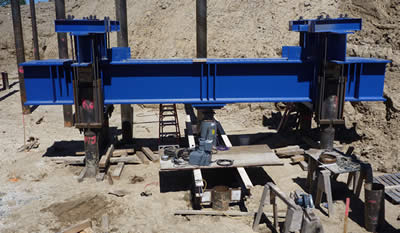
Of the 15 videos selected by the TRB to showcase various transportation research and innovations, seven of them featured MnDOT projects or staff, such as the MnPILE project above in Victoria, Minn. The purpose of the project was to evaluate the pile capacity to save time and money on future bridge construction. To see how the evaluation fared, check out the video at http://youtu.be/FJlHE_KB4XE. Photo by Derrick Dasenbrock, Bridge Office
|
A group of MnDOT leaders traveled to the nation’s capital Jan. 13–17 to help showcase Minnesota’s efforts at the world’s largest transportation research conference.
The Transportation Research Board’s 92nd Annual Meeting in Washington, D.C., attracted more than 10,000 attendees from 71 different countries.
MnDOT staff, their local government counterparts and University of Minnesota officials gave dozens of presentations on MnDOT-sponsored research, with topics ranging from mileage-based user fees to managed lanes.
Highlights included Customer Relations Director Karla Rains’ presentation on quality of life performance measures for transportation. The high-profile research won praise from attendees, one of whom called the work “impressive” and lauded MnDOT’s responsiveness to its customers and stakeholders. Other presentations included the Transportation Economic Development program and Transportation for Communities - Advancing Projects through Partnerships.
“MnDOT is recognized as a global leader in transportation, in part because of our commitment to research,” said Linda Taylor, Research Services director. “MnDOT has long been known for being innovative, taking risks and delivering results.”
One MnDOT project led to an award. Saif Jabari, one of the engineers from the University of Minnesota who worked on the SMART Signal system—designed to measure real-time performance of traffic signals on arterial road networks—received a Milton Pikarsky Memorial Award from the Council of University Transportation Centers.
The new “TRB Video Theater” exhibit also gave MnDOT a chance to shine. Of the 15 videos selected by the TRB to showcase various transportation research and innovations, seven of them featured MnDOT projects or staff. You can find them all at http://www.youtube.com/playlist?list=PLY1b5k2L-2v09MN7iZj-cnv4QNMwcE9fj.
MnDOT employees can access an online portal containing all the materials from the TRB Annual Meeting, including technical papers and viewable slides of presentations. (Note that some presentation materials will not be available until March.) |
 |
|

|
 |
TABLE of CONTENTS
 |
New machine helps District 1 to improve pedestrian, bike accessibility on Bong Bridge |
|
By Beth Petrowske, District 1 public affairs coordinator
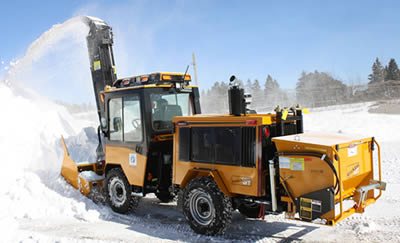
Patrick Geraghty, transportation generalist, tests the new Trackless Machine at D1 Headquarters. Photo by Beth Petrowske |
The Richard I. Bong Bridge connecting Duluth and Superior, Wis., is the longest bridge in Minnesota. At 1.5 miles in length, it rises 120 feet above the St. Louis River, where the wind blows hard and cold during the winter and the sidewalks are usually covered with frozen piles of snow.
In spite of this, there are hardy, ambitious people who regularly bike and walk across the bridge. “Up until now bikers have had to ride on the shoulders during the winter,” said Denis Sauve, owner of Twin Ports Cyclery located near the bridge. “Either that, or quit riding for the winter.”
In addition to limiting mobility, the snow that accumulates on the bridge’s sidewalks contains road salt, which eventually melts, runs over the side of the deck and causes deterioration or “spalling” below the sidewalks. A rehabilitation project is scheduled to begin this summer on the bridge. During this project, significant repairs will be made to the spalled concrete below the sidewalks.
“We have always wanted to provide safe, accessible sidewalks on the bridge, as well as do something to prevent concrete deterioration caused by this melting snow,” said Pat Huston, District 1 maintenance operations engineer. “But, until recently, there wasn’t an adequate machine available that was small-enough to fit on the sidewalks and powerful-enough to blow the heavy snow.”
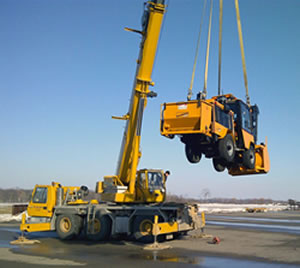
As a safety precaution, the Trackless Machine was fitted with lifting hooks so it can be lifted over a barrier in an emergency. MnDOT file photo |
After months of research, Huston and his team purchased a machine that offers tremendous versatility for maintenance needs. Called a “Trackless Machine,” it will clear the Bong Bridge sidewalks for pedestrians and help prolong the life of the bridge by reducing the salt-water runoff that creates spalling issues under the sidewalk—a win-win solution, according to Huston.
The Trackless Machine will be used primarily on the Bong Bridge, but also will be used on sidewalks near MnDOT buildings, on Hwy 53 near high-volume business areas and on Duluth Metro Area bike paths.
“Funding for equipment is tight—we need equipment that we can do different things with,” said Huston. “The biggest advantage of this machine is its versatility.”
Specifically, the machine has:
- A front mower deck that will be used to mow Interstate 35 medians and back slopes.
- A broom attachment that will be used for sweeping salt, sand, etc., and cleaning out potholes prior to patching.
- A sander attachment that can be used in conjunction with the snow blower.
The district plans to order a milling attachment in the future. Patches made by milling and filling with hot-mix asphalt will be more durable than “throw and go” patches and support MnDOT’s durable patching effort. A boom mower also will be ordered to mow over and around guardrails.
The trackless machine and attachments cost $200,000 and will be kept at the Nopeming Truck Station. Although the machine’s priority will be the Bong Bridge and the Duluth subarea, it will be a shared resource to increase fleet efficiency in the district.
“This is fantastic news,” said Sauve after learning about plans to begin clearing the sidewalks. “This will make many bikers’ commutes a lot easier and safer.” |
 |
|

|
 |
TABLE of CONTENTS
 |
Collaboration key to meeting objectives of Hwy 53 relocation project |
By Jackie Hilgert

This stretch of Hwy 53, which cuts through the United Taconite Mine between Virginia and Eveleth, will be moved by 2017 to allow for mineral extraction. Photo courtesy of Roberta Dwyer |
Seven years isn't a lot of time to move a highway.
That's one reason Roberta Dwyer, District 1/Duluth project manager, said a project management workshop held in November, which brought together all the groups involved in moving the mile-and-a-half segment of Hwy 53 that cuts through the United Taconite Mine between Virginia and Eveleth, was a critical turn in the project's path toward success.
“It illuminated how inter-dependent we are,” Dwyer said. “It opened peoples' eyes; they realized if they are behind or don't get something done, it impacts other sections.”
Dwyer called the two-day process, which was facilitated by the Office of Project Management & Technical Support’s Peter Harff, “extremely helpful.”
A shared understanding of a project’s complexities is critical for all projects, but especially for Hwy 53, which Dwyer said brings unique challenges, such as a completion date set in stone. The highway was constructed in 1960 on land owned by what is now Cliffs Natural Resources. At the time of construction, MnDOT knew easement rights could someday be revoked so the minerals beneath the roadway could be extracted. In 2010, MnDOT was given notice that mining of the land will commence in 2017.
Dwyer said she is in the midst of a draft of an environmental impact statement to determine a new route.
“The initial scoping is done and route options are narrowed to two, with major challenges for each,” she said.
Both routes cut through active mining areas so air quality issues need to be addressed. Further, each route includes a major bridge, which presents seismic issues from blasting occurring in the mine. Also, because MnDOT must construct within an active mine, Mine Safety and Health Administration requirements need to be met. Finally, the amount of right of way for the bridge must be precise because the project encumbers valuable mineral resources.
“We looked nationwide for examples of roads being built through mines, but none of them included the issues we face with this stretch of roadway,” Dwyer said.
Meeting group expectations and maintaining active communication between parties— project management best practices put into action through the workshop—give Dwyer the tools she needs to manage the intricacies of this project and its aggressive timeline. The 30-year MnDOT veteran, who inherited the Hwy 53 project less than a year ago after finishing work on the I-35 Mega Project, has initiated bi-weekly conference calls with the project team to facilitate on-going discussions among groups involved in the project and to review progress.
“It's been a good way to ensure expectations are being met,” Dwyer said. |
 |
|

|
 |
TABLE of CONTENTS
 |
On the job: For the record, Pam Newsome keeps track of MnDOT’s |
By Nicole Kostohyrz, Office of Chief Counsel
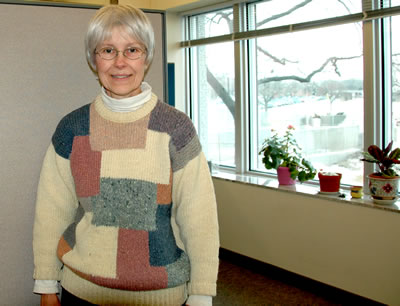
Pam Newsome brings her expertise and training as a librarian and management analyst to her job as MnDOT's records manager. Photo by Nicole Kostohryz |
Pam Newsome may only have been MnDOT’s records manager since January 2012, but the knowledge she’s gained through her other 26 years’ experience with the department has contributed to the work she does today.
She started here in September 1985 as a librarian, a job she performed for 15 years before switching to the Management Analysis Unit, and then the Electronic Document Management System Unit. Newsome said she loves her job because she gets to work with people all over MnDOT and gets to learn a lot about all the documents and records MnDOT uses and creates.
What are you working on now?
I’m currently updating and reorganizing the department’s retention schedule and working on how the SharePoint implementation will manage electronic documents. It is important to manage records according to MnDOT’s approved retention schedule because it is required by state law; if we do not comply it puts us, as an agency at risk. If we keep things either too long or not long enough it also puts us at risk and demonstrates inconsistency.
What does a typical day look like for you?
Typically, I might start my day by answering any questions—either by email or telephone—about retention schedules or what to do with certain materials. I also help with collecting and scanning materials for litigation holds. I regularly meet with groups who need to make changes to their schedule or who have identified a type of record that is not adequately addressed in the schedule and needs to be better managed. I’m also involved in the document and records management discussions of various projects or processes, such as the SharePoint Implementation. And I update the database that tracks boxes at the Records Center. MnDOT’s Central Office in St. Paul uses the Records Center; most of the district offices store their documents on site.
Who makes MnDOT’s retention schedule?
There is a process to make the retention schedule. The first step involves the business units and the records manager working together to identify the business and retention requirements. Next, the State Records Disposition Panel has to approve the schedule that we have made. The panel is made up of people from the Historical Society, Legislative Auditors and the Attorney General’s Office.
Records with
a retention schedule (examples)
- Construction plans
- Financial information
- Personnel documents
- Land acquisitions records
- Contracts
- Permits
- Agreements
|
What are some examples of documents that are a part of the retention schedule?
Generally, documents that record the business we do or what we do at MnDOT. Some examples of documents that are records include construction plans, financial information, personnel documents, land acquisitions records, contracts, permits and agreements. Those are just some of the main ones, but the list goes on.
There are certain types of material that you do not need to keep, according to the retention schedule. These include copies of a document that someone else maintains, drafts after the final product is complete, reference materials, and items not related to MnDOT business. If you are ever in doubt please contact me. I am always willing to help. MnDOT’s records retention schedule is also available online.
What role does records management play in litigation holds and data practices requests?
I collect the hard copy documents for litigation holds and arrange to get them scanned so they are in an electronic format, which makes it easier for the Office of Chief Counsel to review and search for data that is needed. Whenever a litigation hold comes into place, we must keep everything we have related to that hold, and suspend the regular retention schedule for those materials.
For data practices requests, we have to supply everything we have in our possession. If MnDOT keeps materials longer than required by the retention schedule we have to supply the data to the requestor because we have it in our possession. Supplying unnecessary materials for litigation holds and data practices requests uses a lot of resources and can be very costly.
Do you or a co-worker have an interesting job to share with readers? Click here to send us your ideas, and we’ll contact you for more information.
Recent employee profiles:
|
 |
|

|
 |
TABLE of CONTENTS
 |
African-American History Month events focus on commuter rail, history of Pullman Porters |
MnDOT’s African-American employee resource group will host three events in February as part of African-American History Month that highlight the history of African-Americans in commuter rail and the Pullman Porters, who are considered the ambassadors of rail for more than 100 years.
African-Americans Then and Now: Commuter Rail to Light Rail
Wednesday, Feb. 13
11:30 a.m.-1 p.m.
Minnesota History Center, 3M Auditorium
Panelists include:
- Bobbie Hickman—Nephew of Gordon Parks, who was a railroad porter
- Victoria Hopwood—MnDOT employee and daughter of Reginald Hopwood, former railroad waiter
- Gary Nelson –42-year employee of the Great Northern Railway
Students from Gordon Parks High School will also give a video presentation.
The event is sponsored by MnDOT, Minnesota History Center, Metro State University, Minnesota Transit Museum Jackson Round House, Union Depot—Jones Lang LaSalle Retail, Pullman Porter Representative and the Gordon Parks School.
The Railroad Experience of the Pullman Porters: From Servitude to Unionization to Civil Rights
Wednesday, Feb. 27
11:30 a.m.-12:30 p.m.
MnDOT Central Office Rooms G13-14
AND
Thursday, Feb. 28
11:30 a.m.-12:30 p.m.
Metro District Water’s Edge building, Video Conference Room 176
These brown bag discussions will host special guest Gary Nelson, a 42-year employee of the Great Northern Railway. Topics include how members of the Brotherhood of Sleeping Car Porters:
- Influenced the railroads to change policies
- Organized and maintained one of the biggest and most powerful unions for almost 100 years
- Inserted themselves into the civil rights struggles
The session will also focus on some of these men who went on to help build a thriving black middle class in St. Paul.
The African-American employee resource group will also have a poster display in the Central Office first floor lobby area depicting the Brotherhood of Sleeping Car Porters and its 101-year story from servitude to unionization to civil rights.
More event details will become available closer to the events. For more information on all MnDOT African-American History Month events, contact Victoria Hopwood or Keith Baker.
|
 |
|

|
 |
TABLE of CONTENTS
 |
March 6 leadership book discussion centers on “magic of mindset” |

Ronald Bennett, co-author of Leadership for Engineers: The Magic of Mindset, will discuss his book with employees. |

Nicole Peterson, Office of Project Management, will lead the March 6 Commissioner's Reading Corner discussion. |
Nicole Peterson, Office of Project Management, and author Ronald Bennett will lead the March 6 Commissioner’s Reading Corner book discussion of Leadership for Engineers: The Magic of Mindset by Ronald Bennett and Elaine Millam. The one-hour presentation/discussion begins at 1:30.
Employees are invited to attend the event in person in the library at Central Office or participate virtually via Adobe Connect by logging in as a guest. All employees are encouraged to attend, even if they have not yet read the book.
For more information on the Commissioner’s Reading Corner, visit ihub/readingcorner or contact Qin Tang, MnDOT librarian, at 651-366-3784.
An interview with Peterson and her reaction to the latest book will be posted on the ihub/readingcorner website. |
 |
|
| |
|



